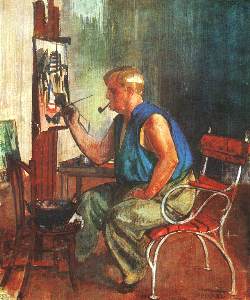Vilmos Aba-Novák on:
[Wikipedia]
[Google]
[Amazon]
 Vilmos Aba-Novák ( hu, Aba-
Vilmos Aba-Novák ( hu, Aba-
'' Encyclopædia Britannica''. 21 January 2007.) was a Hungarian painter and graphic artist. He was an original representative of
Works at Wikiart
Works at Artnet
Robert Edwards, ''Vilmos Aba Novák''
1894 births 1941 deaths Artists from Budapest Hungarian painters Expressionist painters Hungarian people of Austrian descent Burials at Farkasréti Cemetery {{Hungary-painter-stub
 Vilmos Aba-Novák ( hu, Aba-
Vilmos Aba-Novák ( hu, Aba-Novák
Novak (in Serbo-Croatian and Slovene; Cyrillic: ), Novák (in Hungarian, Czech and Slovak), Nowak or Novack (in German and Polish), is a surname and masculine given name, derived from the Slavic word for "new" (e.g. pl, nowy, cz, nový, sh ...
Vilmos, until 1912: hu, Novák Vilmos; March 15, 1894 – September 29, 1941"Aba Novák, Vilmos."'' Encyclopædia Britannica''. 21 January 2007.) was a Hungarian painter and graphic artist. He was an original representative of
modern art
Modern art includes artistic work produced during the period extending roughly from the 1860s to the 1970s, and denotes the styles and philosophies of the art produced during that era. The term is usually associated with art in which the tradi ...
in his country, and specifically of its modern monumental painting. He was also the celebrated author of fresco
Fresco (plural ''frescos'' or ''frescoes'') is a technique of mural painting executed upon freshly laid ("wet") lime plaster. Water is used as the vehicle for the dry-powder pigment to merge with the plaster, and with the setting of the plaste ...
es and church murals at Szeged and Budapest, Chambers Biographical Dictionary, , page 1 and was officially patronized by the Hungarian nobility.
Biography
Novák was born in Budapest, Hungary, where he would also die. His father was Gyula Novák, and the mother was Rosa Waginger ( hu, Waginger Róza from Vienna. After studying at the Art School until 1912, he began work underAdolf Fényes
Adolf Fényes, originally Fischmann (29 April 1867, Kecskemét - 14 March 1945, Budapest) was a Hungarian painter of Jewish ancestry. He is best known for his cycle of paintings; ''The Life of a Poor Man'' and a series of still-lifes, done as tabl ...
. Between 1912 and 1914, Novák studied at the College of Fine Arts in Budapest. Completing his service in the Austro-Hungarian Army on the Eastern Front during World War I, he took up drawing with Viktor Olgyai
Viktor Olgyai, originally Viktor Matirko (1 November 1870, Igló - 20 June 1929, Salzburg) was a Hungarian painter and graphic artist. His family's name was changed in 1892.
Biography
His father was a retired district judge. When he was still a ...
.
Between 1921 and 1923, he spent his summers with the group of artists in Szolnok and Baia Mare (''Nagybánya''), Romania (''see Baia Mare School''), and was first exhibited in 1924. He was sent by the Hungarian Academy
The Hungarian Academy of Sciences ( hu, Magyar Tudományos Akadémia, MTA) is the most important and prestigious learned society of Hungary. Its seat is at the bank of the Danube in Budapest, between Széchenyi rakpart and Akadémia utca. Its ma ...
as a Fellow on a scholarship to Rome (1928 and 1930).
Aba Novák painted many frescoes for the Roman Catholic Church of Jászszentandrás
Jászszentandrás is a village in Jász-Nagykun-Szolnok county, in the Northern Great Plain region of central Hungary.
Geography
It covers an area of .
Population
It has a population
Population typically refers to the number of people ...
, and Hõsök Kapuja (''Heroes' Gate'' - a rare Hungarian example of novecento
Novecento is Italian for “nine hundred” and refers to the 1900s (i.e., one-thousand-and-''nine-hundreds,'' which is a near-synonym for the 20th century). It may also refer to:
* Novecento (group), Italian music group
* Novecento Italiano, a st ...
architecture, commemorating World War I soldiers) in Szeged in 1936 (the latter was white-washed after 1945, restored between 1986 and 2000), and painted many commissions for the Hungarian government. Aba also worked on frescoes of the St. Stephen's Mausoleum
St. Stephen's Mausoleum is a memorial building to Stephen I of Hungary in Székesfehérvár, Hungary. It was built in the late 1930s behind the excavated ruins of the Basilica of the Assumption of the Blessed Virgin Mary where Stephen had been orig ...
in Székesfehérvár
Székesfehérvár (; german: Stuhlweißenburg ), known colloquially as Fehérvár ("white castle"), is a city in central Hungary, and the country's ninth-largest city. It is the regional capital of Central Transdanubia, and the centre of Fejér ...
and on the Church in Városmajor, Budapest, in 1938. The jury's Grand Prize at the Paris World Exhibition in 1937 and the 1940 Venice Biennale were both awarded to him.
He was a teacher at the College of Fine Arts from 1939 until his death.
References
External links
Works at Wikiart
Works at Artnet
Robert Edwards, ''Vilmos Aba Novák''
1894 births 1941 deaths Artists from Budapest Hungarian painters Expressionist painters Hungarian people of Austrian descent Burials at Farkasréti Cemetery {{Hungary-painter-stub